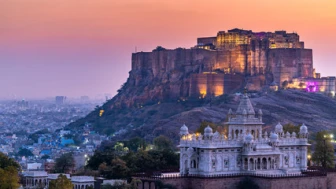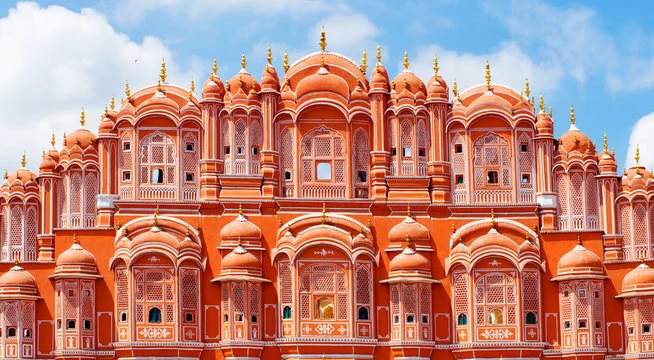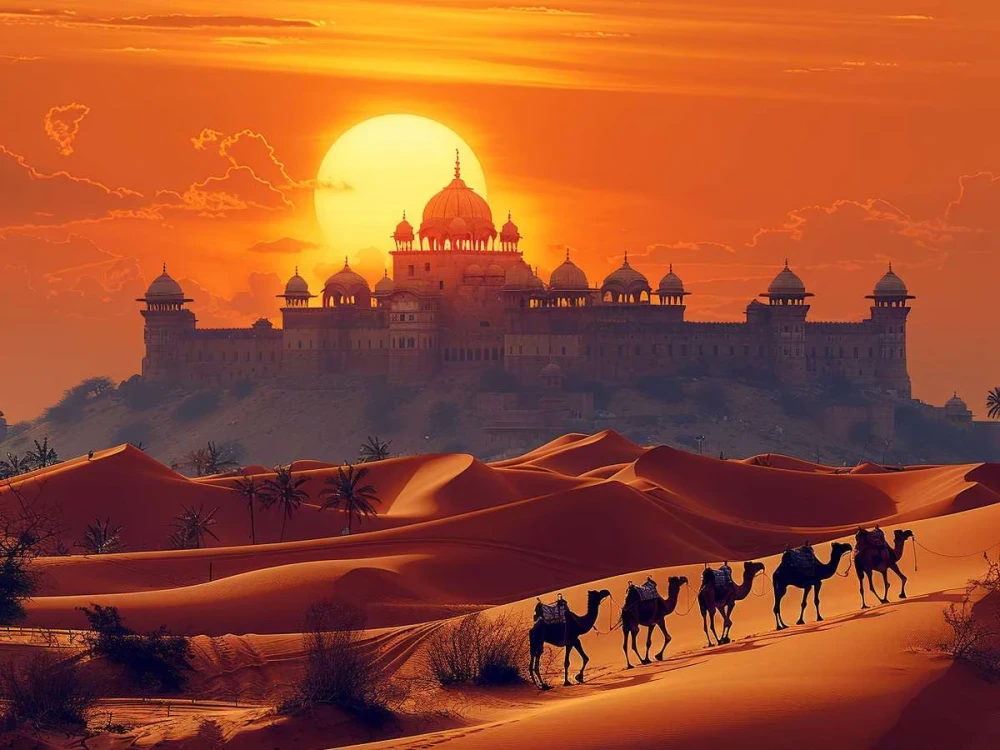




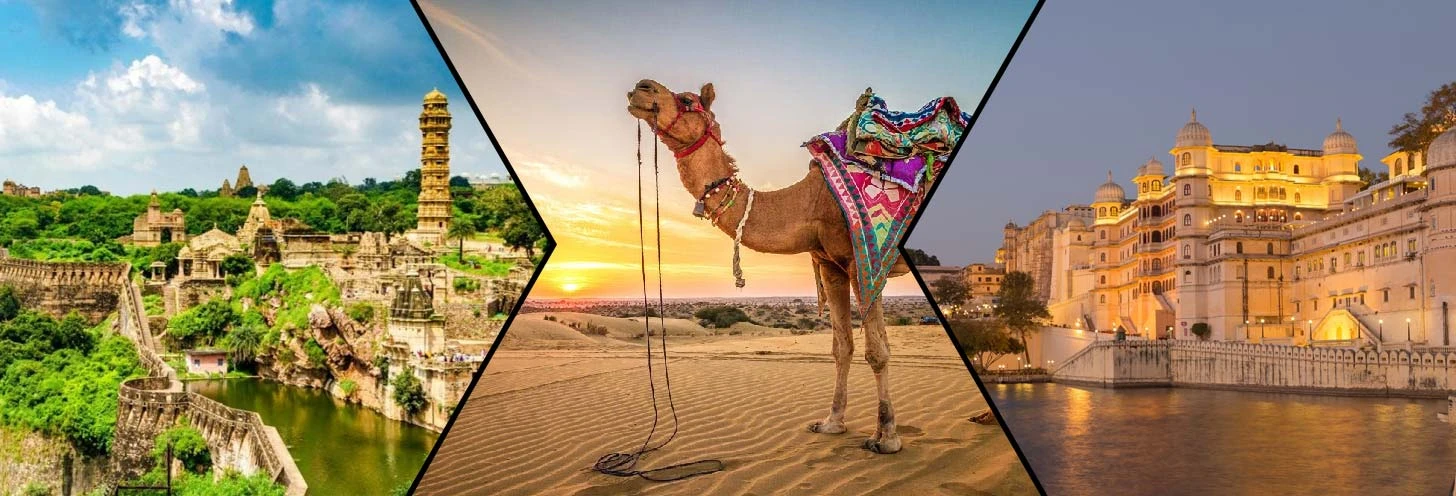

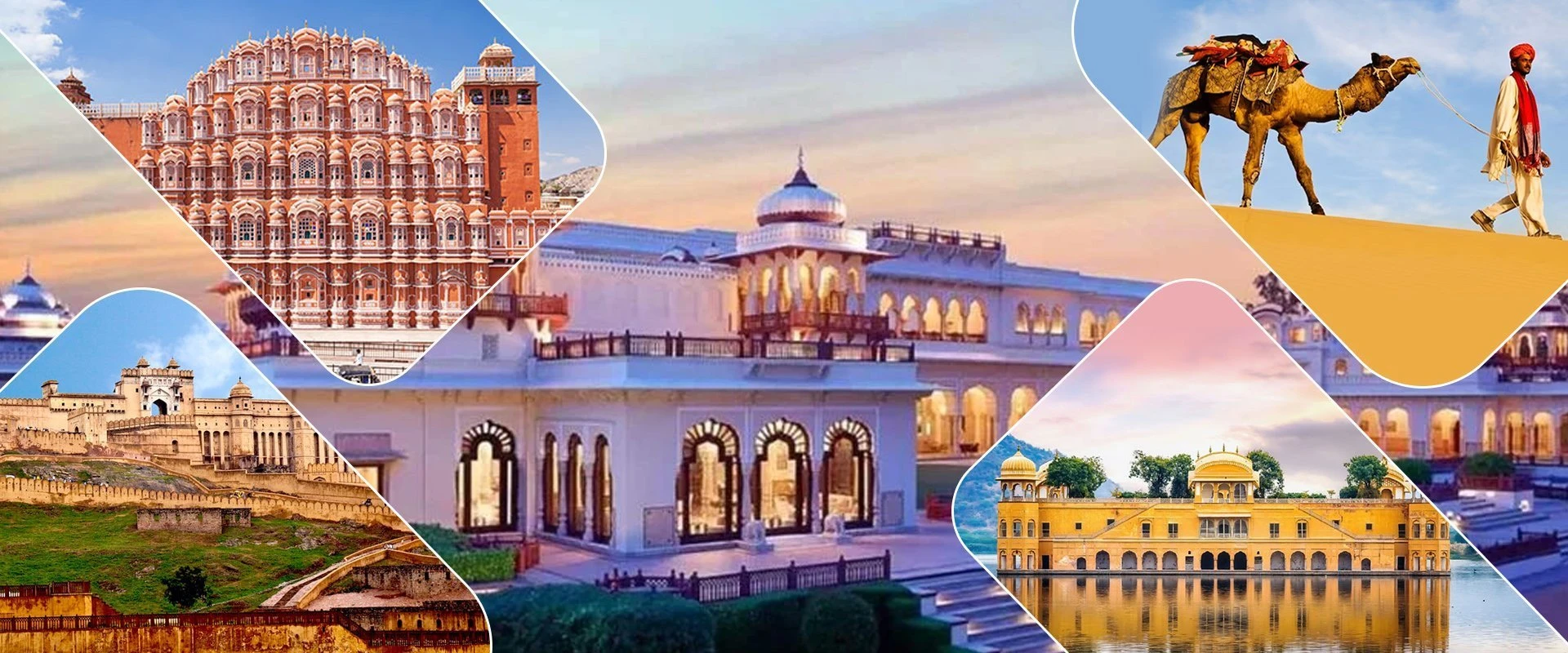


Tour Packages in Rajasthan


Rajasthan isn’t a place that simply invites you to travel. It summons you to live the life of royal Indian culture and tradition. You can feel the air rich with the scent of sandalwood and spices. The architecture of Rajasthan gives its forts a timeless presence, as if they rise straight from the golden desert. You will be hearing the soothing sound of folk songs echoing through the marble courtyards. To delve into this amazing culture and to experience the heritage sights, we created the perfect Rajasthan Tour Packages in 2025. This package is especially crafted to bring you closer to the soul of the golden desert state of India.
In Rajasthan, every activity is soaked in authenticity, whether you are sipping tea on a rooftop in Jaipur, gliding into a boat through the serene lakes of Udaipur, walking in the blue lanes of Jodhpur, or relaxing under a starry sky in Jaisalmer. Rajasthan is a place where staying in a palace, riding camels, and walking through heritage sites are not curated activities; these are part of everyday life.
Rajasthan offers a variety of travel options. If you are looking for a romantic getaway, then we can create perfect romantic honeymoon packages or couple-friendly packages of Rajasthan with all the necessary amenities, especially focused on giving you as much privacy as we can. We also have the packages for family-friendly sightseeing tours and an adventure somewhere in the desert. You can start your trip in the Golden Triangle and move into the Thar, or simply combine the desert safaris and luxury palaces, all without entangling in the hassle of the booking process.
What sets our packages apart is the local connection. We work with heritage stays, trusted guides, and on-ground teams who understand the region like family. No generic circuits. Just meaningful journeys filled with the best of Rajasthan tourism.
Let’s help you create a Rajasthan trip you’ll want to take again. Talk to our Rajasthan travel expert today and get your 2025 journey mapped out your way.
Rajasthan doesn’t come into the list of the usual destinations; it’s a state compiled with contrasting landscapes, cultures, and timeless traditions to create a perfect picture fitted into one frame. Instead of following the maps and getting lost in them, you can explore this state by theme. Whether it’s royal grandeur, golden deserts, or tranquil lakeside retreats, this guide will help you find the perfect destination for your Rajasthan trip according to your choice of travel style.
Royal Cities & Heritage Hubs
Best for: History lovers, luxurious and royal stays, architecture, and walking tours.
Jaipur
The iconic Pink City, where all the trips start. Roam through the huge architecture and learn about the history at the Amber Fort. The artistry of Hawa Mahal and City Palace is admirable and beautiful. Walk through the market that is painted pink, and take blue pottery, gemstone jewellery, and handcrafted textiles with you as souvenirs.
Udaipur
Udaipur is the best destination for a perfect romantic getaway in Rajasthan. Spending time with your partner in this city is quite charming. The heritage havelis and serene lakes give you the feeling of royalty, and the views from the City Palace will melt your heart. And last but not least, the boat ride on Lake Pichola in the evening can be the most unforgettable moment of your romantic trip to Udaipur.
Jodhpur
Spread under the towering Mehrangarh Fort, the Blue City captures Rajasthan’s spirit in its winding alleys, spice-laden markets, and indigo-painted walls. Perfect for cultural immersion and candid photography.
Bikaner
Rich in heritage and lesser-trodden, Bikaner is home to the magnificent Junagarh Fort, detailed merchant havelis, and the soul of Rajasthan’s camel culture.
Alwar & Bundi
If you're seeking stories over crowds, these towns deliver. Alwar offers forested hills and forts, while Bundi charms with ancient stepwells, delicate murals, and quiet lanes.
Desert Landscapes & Golden Towns
Best for: Camel rides, desert nights, folk music, stargazing
Jaisalmer
Rising from the heart of the Thar Desert, this Golden City stuns with its honey-hued sandstone fort, desert hamlets, and sweeping dunes. Ride a camel at sunset, dine by a bonfire, and sleep beneath the stars in a traditional desert camp.
Barmer & Osian
For those venturing off the usual trail, these towns offer untouched Rajasthan's ancient temples, painted mud homes, and wide, open skies that silence everything else.
Lakes & Romantic Retreats
Best for: Honeymoons, boutique stays, slow travel
Udaipur
Udaipur, which is also known as the City of Lakes, offers elegance and tranquillity in the same measure. The views of Lake Pichola and Fatehsagar are amazing from your heritage hotels. The best of the city is sipping your tea from the rooftop cafes or restaurants and enjoying the views. The twilight boat rides are a must-try activity in Udaipur.
Pushkar
Set around a sacred lake, Pushkar is a town where spirituality flows through every ghat and temple. Whether you're walking along the quiet lake or sipping coffee at a rooftop café, the place has its rhythm. If you happen to be there during the Pushkar Camel Fair, the whole town turns into a festival of colours, music, and local life.
Mount Abu
Rajasthan’s only hill station, Mount Abu, is where people go when the plains start to feel too hot. It’s breezy, peaceful, and made for slow days. Sit by Nakki Lake or walk up to the finely carved Dilwara Temples. The place doesn’t rush you; it lets you breathe.
Wildlife & Nature Reserves
Best for: Jungle safaris, birding, photography, and forest escapes
Ranthambore National Park
Ranthambore is where most people head if they want to see tigers in the wild. But it’s not just about the big cats. Leopards, marsh crocodiles, and over 300 bird species live here, too. The setting is dramatic, with a ruined fort overlooking the forest. It pairs well with a trip to Jaipur or Bundi.
Keoladeo National Park (Bharatpur)
This is one of the best bird sanctuaries in the country, and it’s even on the UNESCO list. In winter, it fills up with migratory birds, and photographers come from everywhere. The trails are easy to walk or cycle through, making it a good option for a quiet day with nature.
Sariska Tiger Reserve
Sariska is just a few hours from Delhi and close to Alwar and Jaipur, which makes it easy to add to your trip. It’s not as busy as Ranthambore, but the forest is beautiful and still. Tigers live here too, along with other wildlife, and the silence of the place is often what stays with you.
Cultural Towns & Festival Spots
Best for: Traditional fairs, local festivals, heritage walks, and spiritual stops
Ajmer & Pushkar
These two towns are close enough to do in a single day, but both have their own feel. In Ajmer, the Dargah Sharif draws pilgrims all year round. In Pushkar, it’s the lake, the temples, the narrow alleys, and the rooftop cafés that stay with you. Visit both to feel two different sides of Rajasthan.
Nagaur, Shekhawati & Chittorgarh
Each of these places brings you something different. Shekhawati has painted havelis that are unlike anything else in the state. Nagaur gives you a taste of rural Rajasthan, especially during its smaller fairs. Chittorgarh is about stories of battles, honour, and pride told through stone and silence as you walk through the massive fort.
Rajasthan is not a checklist; it is a story you walk through. With our Rajasthan Tour Packages 2025, we help you discover what matters: the experience, the heritage, and the rhythm of a land that resonates with one’s soul.
Desert Experiences & Offbeat Trails
Best for: Dunes, camel rides, desert nights, and places beyond the tourist path
Jaisalmer
This is the city where the desert starts to feel real. Walk through the narrow lanes of the living fort, where people still run shops and homes inside the golden walls. As the day ends, head to Sam or Khuri dunes, sit by the fire, watch folk dancers perform under the stars, and stay the night in a desert camp. The camel ride across the dunes at sunset is one of those things you remember long after the trip ends.
Bikaner
Not everyone heads to Bikaner, and that’s exactly why it still feels raw and real. The Junagarh Fort here stands firm, with carvings and courtyards that speak of the past. The local markets are full of flavours, especially the namkeens and sweets Bikaner is known for. The camel breeding farm gives you a closer look at desert life, and the Karni Mata Temple stays in your memory for reasons you won’t forget.
Osian & Khimsar
Some places don’t come up in every travel planbut maybe they should. Osian has old temples that have stood quietly for centuries, and the desert around it stretches out in silence. Khimsar has its fort, and not far from it, the dunes open up for a peaceful evening by the fire. These are the kind of places where you don’t rush. You sit, listen to the wind, and feel like the journey has finally slowed down.

Choosing when to visit Rajasthan is just as important as deciding where to go. The state wears a different look with each season, and the experience you have depends entirely on the time you choose to travel. Here’s a detailed, season-wise guide to help you plan your Rajasthan tour package for 2025 with clarity and confidence.
Winter is widely considered the best time to visit Rajasthan, thanks to its pleasant weather and vibrant festivals. Days are sunny and perfect for exploring the forts, palaces, and markets, while evenings are cool enough to enjoy cultural shows and rooftop dinners.
Why travel now:
This is the peak travel season when destinations like Jaipur, Jodhpur, Udaipur, and Jaisalmer are at their best. The cool temperatures allow you to explore comfortably, whether you’re walking through ancient cities or heading out on a camel safari in the Thar Desert.
Major festivals to look forward to:
Pushkar Camel Fair (November), Jaipur Literature Festival (January), Desert Festival in Jaisalmer (February), Mewar Festival in Udaipur (March).
Recommended for:
Couples, families, photographers, and cultural travellers looking for a complete and comfortable Rajasthan experience.
Summers in Rajasthan can be intense, especially in the desert regions. However, this season offers a quieter and more affordable way to explore the state. Tourist numbers drop, and many luxury hotels offer discounts during this period.
Why it’s still worth considering:
While most cities heat up, Mount Abu, the state’s only hill station, stays cooler and is perfect for a short summer retreat. Travellers willing to explore early in the morning or later in the evening can still enjoy the forts, bazaars, and heritage walks without the rush.
What to expect:
Budget-friendly travel, peaceful stays, and fewer crowds. Many palace hotels provide excellent deals, making it ideal for those seeking privacy and space.
Recommended for:
Budget travellers, couples, and off-season explorers are comfortable with warm weather.
The monsoon season brings a surprising change to Rajasthan’s dry landscape. Light showers, greener surroundings, and a fresh look at historic cities create a more relaxed and scenic travel experience.
Why you should travel during the rains:
This season adds a romantic charm to places like Udaipur, where the lakes reflect the monsoon sky beautifully. The Aravalli Hills turn lush, and less-visited destinations such as Bundi, Alwar, and Ranthambore look especially scenic.
Best experiences during this time:
Nature walks, monsoon photography, peaceful palace stays, and spotting wildlife in Ranthambore National Park as the forest turns dense and green.
Recommended for:
Nature lovers, couples, and slow travellers who enjoy offbeat journeys and fewer tourists.
Quick Travel Tip
If you're planning your Rajasthan tour package in 2025, aim for the months between November and February for the most comfortable weather and a full cultural experience. However, if you’re looking to avoid crowds or prefer a quieter and more intimate journey, early summer and monsoon months can offer a refreshing and affordable alternative.
Rajasthan is easy to reach, no matter where you’re coming from. Whether you're flying in for a quick getaway, boarding a long-distance train, or planning a classic road trip, the state offers excellent connectivity from all parts of India. Here's how to navigate your arrival:
By Air – Fastest and Most Convenient
The quickest way to reach Rajasthan is by air. The major citiesJaipur, Udaipur, and Jodhpur, all have airports with regular flights from metros like Delhi, Mumbai, Bangalore, and Ahmedabad. If you’re short on time or planning a multi-city tour, flying in and out of different cities can help you cover more ground efficiently.
Popular Entry Airports:
Jaipur International Airport (JAI)
Maharana Pratap Airport, Udaipur (UDR)
Jodhpur Airport (JDH)
By Train – Widely Connected and Cost-Effective
Rajasthan is part of India’s major rail routes, with most tourist cities having reliable train access. From Delhi and Mumbai, daily trains run to Jaipur, Udaipur, Jodhpur, and Bikaner. It’s a good option if you enjoy overland travel and want to experience the countryside along the way.
Trains like the Shatabdi, Duronto, and Superfast Express make the journey comfortable and fairly quick, especially from North and Central India.
By Road – Best for Nearby Travelers and Scenic Routes
If you’re traveling from Delhi, Haryana, Punjab, or Gujarat, a road trip is not just feasible but enjoyable. The highways leading into Rajasthan are smooth and well-marked. Driving lets you explore places en route, such as Neemrana, Pushkar, or Kumbhalgarh.
Bus services by RSRTC and private operators are available too, offering both AC and sleeper options on most routes.
Travel Access from Major Cities
Here’s a quick reference table showing how to reach Rajasthan from major Indian cities, depending on your preferred mode of travel:
| From | By Air | By Train | By Road |
| Delhi | Direct flights to Jaipur, Udaipur, Jodhpur | Daily trains to Jaipur, Jodhpur, and Bikaner | Well-connected highways |
| Mumbai | Direct flights to Udaipur, Jaipur, Jodhpur | Overnight trains to Jaipur, Udaipur | Long drive |
| Bangalore | Non-stop flights to Jaipur, Udaipur | Few direct trains (long journey) | Not recommended by road |
| Ahmedabad | Short flights to Jaipur, Udaipur | Regular trains to Jodhpur, Udaipur | Drive via NH48/NH62 |
| Kolkata | Flights to Jaipur via Delhi | Select long-route trains to Jaipur | Road travel is not practical |
Travel Tip for 2025
If you’re planning your Rajasthan Tour Package in 2025, start by flying into Jaipur or Udaipur and return from Jodhpur for a well-routed trip. Those coming from nearby states can comfortably opt for trains or road journeys. The key is to choose your entry and exit cities based on your planned route. This saves both time and cost while allowing a deeper travel experience.
Rajasthan isn’t one-dimensional. It’s a place where every kind of traveller finds something that speaks to them. Whether you're travelling alone, planning a family vacation, or on a romantic escape, the experiences here are flexible, immersive, and deeply personal. At My Tour Plans, we’ve shaped Rajasthan tour packages to suit each style of travel so you get more than just a trip. You get a journey that fits you.
Solo Traveller Packages – Freedom to Explore Without a Map
For those travelling solo, Rajasthan feels open, approachable, and full of quiet moments that stay with you. Cities like Udaipur, Jodhpur, and Pushkar are not only safe but also incredibly inviting. You can start your day at a palace, wander through local bazaars by afternoon, and end it watching the sky turn orange from a rooftop café. There's no pressure to rush, just space to experience.
What’s included in our solo tour packages:
Stays in centrally located hostels or boutique guesthouses
Private transfers for city-to-city ease
Add-on options like guided walks, food tours, or village experiences
These packages are built for those who enjoy moving at their own pace, following instinct, and discovering Rajasthan one step at a time.
Family Packages – Comfortable, Covered, and Completely Worth It
Rajasthan is one of those rare destinations that works perfectly for families. Every city brings something different to the table, from puppet shows and camel rides in Jaipur to wildlife safaris in Ranthambore and boat rides in Udaipur. The travel is smooth, the hotels are family-ready, and the itinerary keeps everyone interested without wearing anyone out.
What you’ll get with our family packages:
Spacious vehicles and shorter drives between cities
Hotels with kid-friendly services and modern comforts
Itineraries balanced with sightseeing and downtime
These tours are ideal for school holidays or extended weekends when you want everything arranged so the only thing left is to enjoy it together.
Couple & Honeymoon Packages – A Royal Escape Made Just for Two
Rajasthan is timeless, and that’s exactly what makes it romantic. Imagine waking up in a palace overlooking a lake, walking hand-in-hand through quiet fort passages, or dining in a candlelit courtyard where the only sound is the evening breeze. Whether it’s your honeymoon or just time away for two, Rajasthan adds atmosphere to every moment.
Our couple and honeymoon packages include:
Handpicked heritage stays that are both elegant and intimate
Private experiences like desert dinners, sunset boating, or spa sessions
Custom plans with relaxed pacing and moments built just for you
These are for couples who want something more than just a sightseeing journey full of warmth, comfort, and unforgettable settings.
Watch the sunrise over Amber Fort and take in Jaipur’s morning stillness
Glide across Lake Pichola in Udaipur as the palaces glow at sunset
Go on a wildlife safari in Ranthambore and explore its ruins and forests
Walk through the painted havelis of Shekhawati and uncover forgotten art
Immerse yourself in the energy of Pushkar Fair and its vibrant traditions
Explore the massive ramparts of Chittorgarh Fort and relive tales of courage
Wander through the blue lanes of Jodhpur’s old city at your own pace
Enjoy folk performances under the stars in Jaisalmer or Jaipur
Spend a peaceful night in the Thar Desert with traditional food and music
Browse Rajasthan’s colourful markets filled with textiles, crafts, and local stories
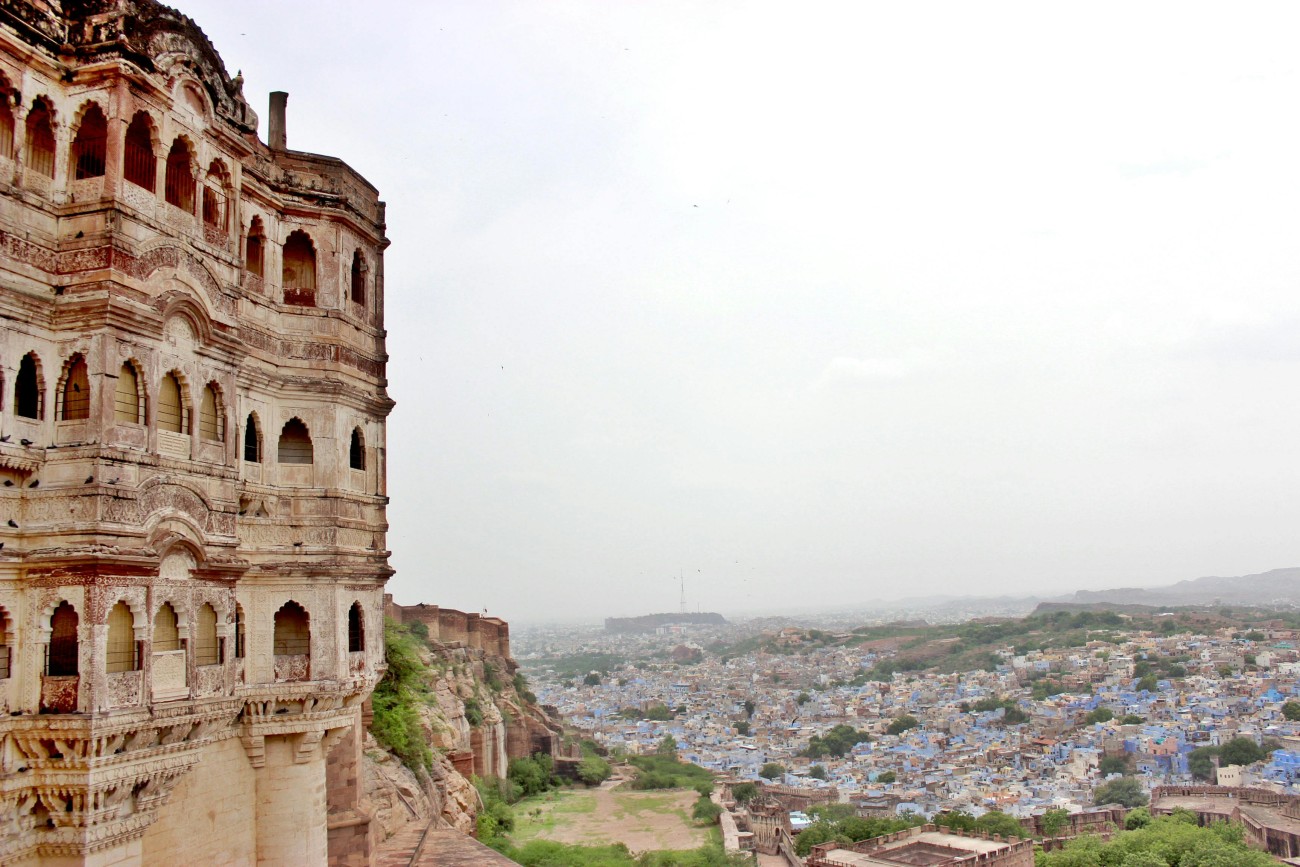
Rajasthan's charm is not just in its palaces and forts, but also in the places you stay. Whether you want royal elegance, local character, or something budget-friendly, Rajasthan offers stays that enhance your experience.
| Type of Stay | Ideal For | Highlights |
| Heritage Hotels | Couples, History lovers | Palatial architecture, cultural ambiance, and lake views |
| Desert Camps | Adventure seekers, Families | Dune stays, folk performances, stargazing |
| Boutique Havelis | Solo travelers, Culture lovers | Intimate stays, local hosts, heritage feel |
| Luxury Resorts | Honeymooners, Relaxation seekers | High-end amenities, spas, privacy, scenic locations |
| Budget Guesthouses | Backpackers, Budget travelers | Clean, central, value for money |
What to Expect
Heritage hotels in Jaipur, Udaipur, and Jodhpur offer regal interiors, traditional hospitality, and a glimpse into royal Rajasthan.
Desert camps in Jaisalmer or Osian are perfect for an evening of folk music, sunset camel rides, and sleeping under open skies.
Boutique havelis located within city forts or old quarters offer the character, warm hosts, and a personal touch.
Luxury resorts blend comfort with a cultural setting ideal for couples seeking a quiet escape.
Budget stays are easily available near major attractions and offer simplicity with essential comforts.
No matter your travel style, Rajasthan offers stays that are as immersive and diverse as the destination itself.
In Rajasthan, festivals are part of daily life. They aren’t just seasonal highlights, but windows into the heart of its culture. Every celebration, big or small, brings communities together through music, colour, faith, and centuries-old rituals. These are the moments when the state feels most alive.
| Festival | Where It's Celebrated | What Makes It Special |
| Pushkar Camel Fair | Pushkar, Ajmer | Livestock trading, local sports, folk music, and spiritual gatherings |
| Desert Festival | Jaisalmer | Dune-side festivities, camel races, fire dances, vibrant costumes |
| Teej Festival | Jaipur | Swing rituals, monsoon songs, processions of women in green attire |
| Gangaur Festival | Udaipur, Jaipur | Women's rituals for marital harmony, grand street parades |
| Mewar Festival | Udaipur | Spring celebrations, decorated boats on Lake Pichola, and cultural shows |
A few more experiences worth timing your trip around:
Each event holds deep cultural meaning for locals. They aren't choreographed for touriststhey are traditions passed through generations. Experiencing one gives you far more than just good photos. It offers perspective, connection, and a glimpse into what makes Rajasthan truly unforgettable.
Rajasthan offers more than just sightseeing; it lets you choose how you want to travel. Whether you’re heading out as a family, planning a couple’s escape, or exploring solo, each package follows a pace and mood that suits your journey. Here’s a guide to help you match your travel style with the right Rajasthan tour.
Popular Tour Styles at a Glance:
| Travel Style | Ideal For | Key Destinations |
| Heritage & Culture | First-time travellers, history lovers | Jaipur, Udaipur, Jodhpur, Jaisalmer |
| Desert Safari | Couples, photographers, adventure seekers | Jaisalmer, Bikaner, Khimsar |
| Luxury Getaways | Honeymooners, senior travellers | Udaipur, Jaipur, palace resorts |
| Wildlife Tours | Nature lovers, families with kids | Ranthambore, Sariska, Bharatpur |
| Spiritual Circuits | Pilgrims, culturally curious | Pushkar, Ajmer, Nathdwara |
| Short Escapes | Weekend planners, budget travellers | Alwar, Pushkar, Jaipur (from Delhi) |
Highlights of Each Type:
Each package can be customised, so you travel your way with the comfort, pace, and purpose that suits you.
Rajasthan is not a place you simply visit; it's a destination you live through at every turn, every sound, and every story. Regardless of whether you are planning a cultural immersion, a family getaway, a romantic escape, or a solo trip, My Tour Plans creates every itinerary based on what is important to you. Our Rajasthan Tour Packages 2025 take service incredibly seriously, with uncomplicated routes, real experiences, and accommodation and travel that get you closer to the region, rather than simply staring at landmarks. There will be no frantic, rushed sightseeing, and no bog-standard stops - just easily manageable travel; the way it should be. You just need to tell us how you want to travel, and we will do the rest.
Start planning your journey to Rajasthan - speak to our experts today to get your personalised itinerary.

My Tour Plans Pvt.Ltd.
4th Floor, C-88, Sector 2, Noida, U.P, 201301


